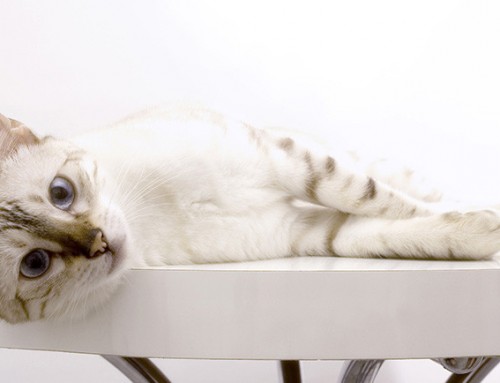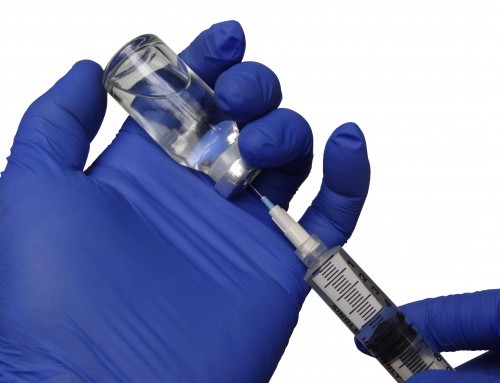Microchipping is a routine, non-invasive procedure where a veterinarian inserts a microchip that contains a unique identification number under a dog or cat’s skin using a hypodermic needle. This procedure is becoming increasingly widespread across the world. Some countries are even starting to require mandatory microchipping of dogs and cats. To help educate pet owners about this growing technology, the American Veterinary Medical Association (AVMA) has developed a comprehensive list of frequently asked questions and answers about microchipping. We’ve included the most common questions here, but be sure to visit the AVMA’s website for more information on international microchipping standards and microchip safety research.
What is a microchip?
A microchip is a small, electronic chip enclosed in a glass cylinder that is about the same size as a grain of rice. The microchip itself does not have a battery—it is activated by a scanner that is passed over the area, and the radiowaves put out by the scanner activate the chip. The chip transmits the identification number to the scanner, which displays the number on the screen. The microchip itself is also called a transponder.
How is a microchip implanted into an animal? Is it painful? Does it require surgery or anesthesia?
It is injected under the skin using a hypodermic needle. It is no more painful than a typical injection, although the needle is slightly larger than those used for injection. No surgery or anesthesia is required—a microchip can be implanted during a routine veterinary office visit. If your pet is already under anesthesia for a procedure, such as neutering or spaying, the microchip can often be implanted while they’re still under anesthesia.
What kind of information is contained in the microchip? Is there a tracking device in it? Will it store my pet’s medical information?
The microchips presently used in pets only contain identification numbers. No, the microchip is not a GPS device and cannot track your animal if it gets lost. Although the present technology microchip itself does not contain your pet’s medical information, some microchip registration databases will allow you to store that information in the database for quick reference.
Why should I have my animals microchipped?
The best reason to have your animals microchipped is the improved chance that you’ll get your animal back if it becomes lost or stolen.
How does a microchip help reunite a lost animal with its owner?
When an animal is found and taken to a shelter or veterinary clinic, one of the first things they do is scan the animal for a microchip. If they find a microchip, and if the microchip registry has accurate information, they can quickly find the animal’s owner.
Will a microchip really make it more likely for me to get my pet back if it is lost?
Definitely! A study of more than 7,700 stray animals at animal shelters showed that dogs without microchips were returned to their owners 21.9% of the time, whereas microchipped dogs were returned to their owners 52.2% of the time. Cats without microchips were reunited with their owners only 1.8% of the time, whereas microchipped cats went back home 38.5% of the time. (Lord et al, JAVMA, July 15, 2009) For microchipped animals that weren’t returned to their owners, most of the time it was due to incorrect owner information (or no owner information) in the microchip registry database – so don’t forget to register and keep your information updated.
Does a microchip replace identification tags and rabies tags?
Absolutely not. Microchips are great for permanent identification that is tamper-proof, but nothing replaces a collar with up-to-date identification tags. If a pet is wearing a collar with tags when it’s lost, it’s often a very quick process to read the tag and contact the owner; however, the information on the tags needs to be accurate and up-to-date. But if a pet is not wearing a collar and tags, or if the collar is lost or removed, then the presence of a microchip might be the only way the pet’s owner can be found.
Your pet’s rabies tag should always be on its collar, so people can quickly see that your pet has been vaccinated for this deadly disease. Rabies tag numbers also allow tracing of animals and identification of a lost animal’s owner, but it can be hard to have a rabies number traced after veterinary clinics or county offices are closed for the day. The microchip databases are online or telephone-accessed databases, and are available 24/7/365.
I want to get my animal(s) microchipped. Where do I go?
To your veterinarian, of course! Most veterinary clinics keep microchips on hand; so, it is likely that your pet can be implanted with a microchip the same day as your appointment. Sometimes local shelters or businesses will host a microchipping event, too.
I just adopted a pet from the animal shelter. Is it microchipped? How can I find out?
If the shelter scanned the animal, they should be able to tell you if it is microchipped. Some shelters implant microchips into every animal they adopt out, so check with the shelter and find out your new pet’s microchip number so you can get it registered in your name.
Most veterinary clinics have microchip scanners, and your veterinarian can scan your new pet for a microchip when you take your new pet for its veterinary checkup. Microchips show up on radiographs (x-rays), so that’s another way to look for one.
Why can’t I just buy the microchip and implant it myself?
It looks like a simple-enough procedure to implant a microchip – after all, it’s just like giving an injection, right? Well, yes and no. Although it looks like a simple injection, it is very important that the microchip is implanted properly. Using too much force, placing the needle too deeply, or placing it in the wrong location can not only make it difficult to detect or read the microchip in the future, but it can also cause life-threatening problems. Microchips should really be implanted under supervision by a veterinarian, because veterinarians know where the microchips should be placed, know how to place them, and know how to recognize the signs of a problem and treat one if it occurs.
Once the microchip has been implanted, what do I do? Is there any sort of maintenance needed?
Once your pet is microchipped, there are only three things you need to do: 1) make sure the microchip is registered; 2) ask your veterinarian to scan your pet’s microchip at least once per year to make sure the microchip is still functioning and can be detected; and 3) keep your registration information up-to-date. If you notice any abnormalities at the site where the microchip was implanted, such as drainage (oozing) or swelling, contact your veterinarian. Ideally, the microchip should be scanned during your animal’s regular wellness/preventive care exams to make sure that it’s still in place and working as it should.
If you’ve moved, or if any of your information (especially your phone number) has changed, make sure you update your microchip registration in the manufacturer’s database as soon as possible.
What are some of the problems associated with microchips? How common are they?
The British Small Animal Veterinary Association (BSAVA) maintains a database of adverse reactions to microchips. Since the database was started in 1996, over 4 million animals have been microchipped and only 391 adverse reactions have been reported. Of these reactions, migration of the microchip from its original implantation site is the most common problem reported. Other problems, such as failure of the microchip, hair loss, infection, swelling, and tumor formation, were reported in much lower numbers. For a chart summarizing the BSAVA reports, read the AVMA’s literature review on Microchipping of Animals.
Why are microchips sometimes not found?
As with almost anything, it’s not a foolproof system. Although it’s very rare, microchips can fail and become unable to be detected by a scanner. Problems with the scanners are also not common, but can occur. Human error, such as improper scanning technique or incomplete scanning of an animal, can also lead to failure to detect a microchip.
Some of the animal-related factors that can make it difficult to detect a microchip include the following: animals that won’t stay still or struggle too much while being scanned; the presence of long, matted hair at or near the microchip implantation site; excessive fat deposits in the region of implantation; and a metal collar (or a collar with a lot of metal on it). All of these can interfere with the scanning and detection of the microchip.
See our literature review for guidelines on scanning procedures to reduce the chances of missing a microchip.
Do the benefits of microchipping outweigh the risks?
The benefits of microchipping animals definitely outweigh the risks. Although we can’t guarantee that a shelter or veterinary clinic will always be able to read every microchip, the risk that this will happen is very low, and getting even lower. Animal shelters and veterinary clinics are very aware of the concerns about missing an implanted microchip, and take extra measures to determine if a microchip is present before a decision is made to euthanize or adopt out the animal. Universal scanners are becoming more available, and solve the challenge of detecting different microchip frequencies. Although the presence of a microchip is not a 100% guarantee that you will get your pet back if it’s lost or stolen, it does dramatically increase the chances you will be reunited with your pet…as long as you keep the registration information up to date.
Towne Center Animal Hospital is fully-equipped for implanting microchips and scanning for them. If you have any questions about the microchipping procedure or would like to schedule an appointment for your pets, please feel free to contact us for more information.







Leave A Comment
You must be logged in to post a comment.